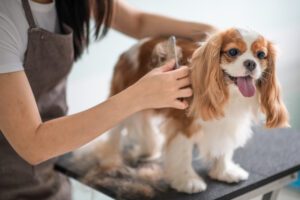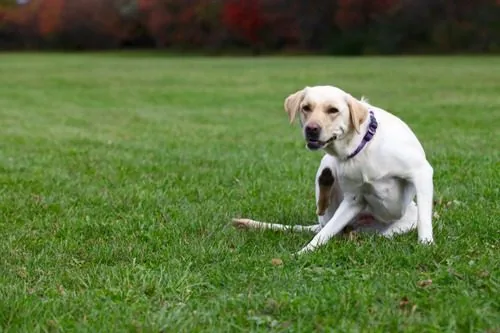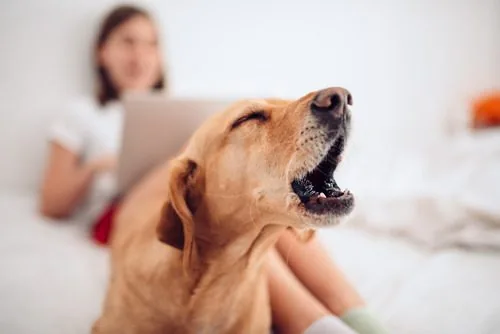Canine Whiskers: What is the Purpose of Your Dog’s Whiskers?
Whiskers are long, thick, and specialized hairs found on dogs and other mammals. While they might seem like just another part of your dog’s furry appearance, whiskers serve way more of an importance than just looking cute. So, what is the purpose of your pup’s whiskers?
Like most mammals, a dog’s whiskers serve many functional purposes as they help your pup navigate and sense changes in their environment. Whiskers even help your dog communicate with other animals as their whiskers help to express their emotions.
In this comprehensive article, we’ll explore the purpose of your dog’s whiskers, how they work, and the importance of maintaining their health and integrity. We will also discuss additional aspects of whiskers, such as breeds with unique whisker characteristics. Let’s get into it!

Why Do Dogs Have Whiskers?
Sensory Perception
Whiskers are rich in nerve endings and blood vessels, making them highly sensitive to touch and vibrations in the environment. They help your dog gather information about their surroundings, including detecting nearby objects, gauging distances, and perceiving changes in air currents. This heightened sensory perception is particularly useful in low-light conditions when your dog’s vision might be limited.
Spatial Awareness
Whiskers help dogs navigate tight spaces and avoid collisions with obstacles. When a whisker touches an object, it sends a signal to the dog’s brain, alerting them to the object’s presence and distance. This allows your dog to maneuver around obstacles with ease and avoid potential injuries.
Emotional Expression
Like other facial features, whiskers can play a role in expressing your dog’s emotions. When your dog is relaxed, their whiskers will rest in a natural position. However, when they’re feeling threatened or aggressive, their whiskers may flare out, indicating their emotional state to other animals or humans.
Hunting and Tracking
Whiskers play an essential role in a dog’s hunting and tracking abilities. The vibrations detected by their whiskers can help them locate prey, even in low visibility conditions. While domesticated dogs may not rely on their whiskers for hunting as much as their wild counterparts, this sensory function is still present and helps your dog explore their environment.
How to Take Care of Your Dog’s Whiskers

Since whiskers serve an important role in your dog’s life, maintaining them is crucial for the well-being of your pet.
Do Not Trim or Cut
It’s crucial to avoid cutting or trimming your dog’s whiskers, as doing so can significantly impair their sensory perception and spatial awareness. This could lead to disorientation, anxiety, and an increased risk of injury.
Groom the Area Around the Whisker
While it’s essential to groom your dog regularly, it is important to take care around their whisker area. Be gentle when brushing or combing near their whiskers to avoid causing pain or discomfort. If your dog’s whiskers become dirty or tangled, carefully clean them using a soft cloth and warm water.
Monitor Whisker Health
Regularly inspect your dog’s whiskers for any signs of damage or irritation. If you notice any issues, such as broken whiskers or skin irritation around the whisker follicles, consult your veterinarian for guidance on appropriate care and treatment.
Protect Your Dog’s Whiskers
Be mindful of your dog’s whiskers when fitting them with collars, harnesses, or other accessories. Make sure that any equipment you use does not put unnecessary pressure on their whiskers or impede their sensory function.
What Are Some Potential Whisker Health Issues?
Just like any other part of your dog’s body, whiskers can be prone to health issues too. Some potential issues include infections, trauma, and allergies.
Infections
In some cases, bacteria or fungi can infect the follicles of your dog’s whiskers, leading to inflammation, redness, and discomfort. If you suspect an infection, consult your veterinarian for appropriate treatment options.
Trauma
Physical trauma, such as being bitten by another animal or getting caught in a small space, can damage your dog’s whiskers. If your dog experiences any form of trauma, monitor their whiskers for signs of damage or discomfort and consult your veterinarian if needed.
Allergies
Allergic reactions, such as those caused by environmental factors or certain grooming products, can also affect your dog’s whiskers. If you notice your dog excessively scratching or rubbing their whiskers, consult your veterinarian for guidance on identifying and addressing the cause of the allergy.
Dog Breeds with Unique Whisker Characteristics
Just like how different dog breeds have different fur and coat characteristics, whiskers can change with the breed as well.
Wirehaired Breeds
Some dog breeds, like the Wirehaired Pointing Griffon and the Wire Fox Terrier, have distinctive coarse hair, including their whiskers. These breeds may require specialized grooming techniques to maintain the health and appearance of their whiskers.
Hairless Breeds
Hairless breeds, such as the Chinese Crested and the Xoloitzcuintli, may have fewer or less prominent whiskers than other breeds. However, it is still essential to ensure that their whiskers remain clean and free from irritation or damage.
Curly Whiskers
Some dog breeds, like the Poodle and the Bichon Frise, have curly whiskers, which can make them more prone to tangling and matting. Regular, gentle grooming is necessary to keep their whiskers healthy and functional.
Conclusion
Canine whiskers play a vital role in your dog’s sensory perception, spatial awareness, emotional expression, and hunting abilities. By understanding the purpose of your dog’s whiskers and ensuring their health and maintenance, you can help your furry friend navigate their environment safely and confidently. If you have any questions or concerns about your pup’s whiskers, reach out to your veterinarian.
For pet parents in the Atlanta, GA region, The Village Vets has 7 practices conveniently located across the Atlanta metro area. Find a location near you today!
Recent Posts
About The Village Vets
The Village Vets is a network of animal hospitals based in Atlanta, GA and the surrounding area. We offer honest, excellent service to our clients in a comfortable, friendly atmosphere. To learn more about our locations and how we can better serve you and your pet, click the button below.
Share This Post
Recent Posts
About The Village Vets
The Village Vets is a network of animal hospitals based in Atlanta, GA and the surrounding area. We offer honest, excellent service to our clients in a comfortable, friendly atmosphere. To learn more about our locations and how we can better serve you and your pet, click the button below.



